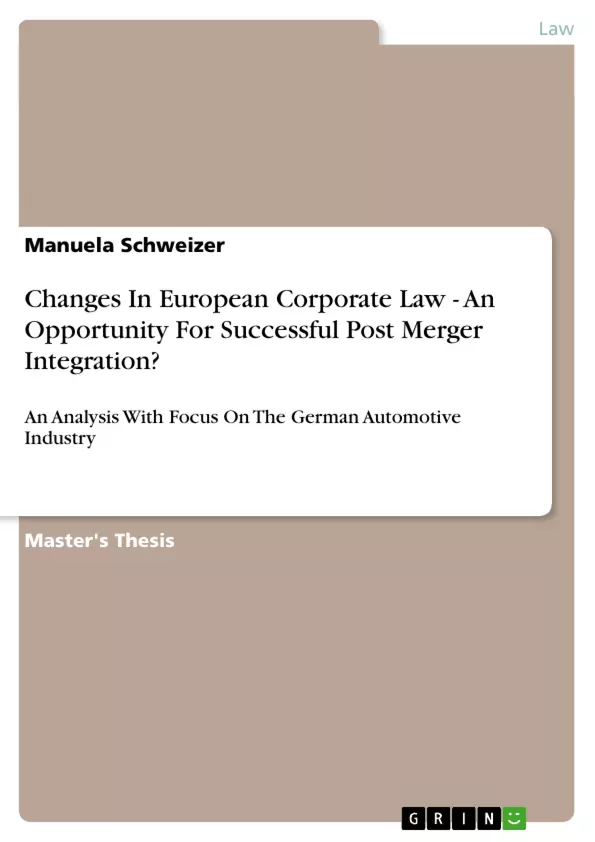This report aims at analysing the implications of changes in European Corporate Law on cross-border mergers, with particular focus on strategic management’s decision on intangible assets of the integration stage. It consists of two parts, (1) an analysis of the implications of changes in European Corporate Law, and (2) an assessment of their impact on post merger integration. Part 1 is about the European Court of Justice’s jurisdiction and its implications on German Corporate Law: It explores how European Law is influencing and thereby changing national law. Having analysed the effect of its rulings on – until recently in continental Europe prevailing – seat theory, I carefully analyse the subsequent developments and trends, including reform of the German Limited Liability Company Act (MoMiG), competition of legal forms, opportunities offered by recently introduced supranational legal forms with particular focus on the Societas Europaea, and EU merger directive with its influence on the German Transformation Act. Part 2 not only critically evaluates prevailing merger integration theories, it also reflects on the opportunities the afore-mentioned changes in European Corporate Law offer to successful post merger integration. Hence, I analyse and further develop Jansen’s 7c model and educe a strategic plan.
Inhaltsverzeichnis (Table of Contents)
- ABSTRACT
- TABLE OF CONTENTS
- LIST OF FIGURES
- LIST OF ABBREVIATIONS
- I. INTRODUCTION
- II. CHANGES IN EUROPEAN CORPORATE LAW: AN OPPORTUNITY FOR SUCCESSFUL POST MERGER INTEGRATION?
- 1. M&A FOUNDATIONS
- 1.1 OVERVIEW ON THE M&A MARKET
- 1.2 TYPES OF M&A DEALS
- 1.3 THE M&A PROCESS
- 2. EUROPEAN CORPORATE LAW
- 2.1 THEORETICAL FOUNDATIONS: ANALYSIS AND CRITICAL EVALUATION
- 2.1.1 CHARACTERISTIC ASPECTS OF GERMAN LAW
- 2.1.2 THE RELATIONSHIP BETWEEN EUROPEAN LAW AND NATIONAL LAW
- 2.1.3 RECOGNITION OF COMPANIES WITH FOREIGN LEGAL FORM
- 2.1.3.1 THE IMPACT OF THE ECJ'S JURISDICTION ON THE APPLICATION OF SEAT THEORY
- 2.1.3.2 CONSEQUENCES: COMPETITION OF LEGAL FORMS AND GERMAN “MOMIG”
- 2.1.4 THE OPPORTUNITIES OF SUPRANATIONAL LEGAL FORMS
- 2.1.4.1 SE SOCIETAS EUROPAEA
- 2.1.4.2 OTHER
- 2.1.5 THE RIGHT TO CHANGE THE LEGAL STRUCTURE
- 2.1.5.1 THE EU CROSS-BORDER MERGERS DIRECTIVE: LEGAL DEVELOPMENT
- 2.1.5.2 GERMANY: NEW OPTIONS FOR CORPORATIONS
- 2.1.5.3 TRANSFORMATION ACT: FORMS TO CHANGE THE LEGAL STRUCTURE
- 2.1.6 TRENDS AND PROSPECTS
- 2.2 APPLYING THEORY TO PRACTICE: EXEMPLIFICATION
- 2.3 FINDINGS: IMPLICATIONS ON POST MERGER INTEGRATION
- 3. POST MERGER INTEGRATION
- 3.1 THEORETICAL FOUNDATIONS: ANALYSIS AND CRITICAL EVALUATION
- 3.1.1 CLASSIFICATION OF THE CONTEXT
- 3.1.2 DEFINITIONS AND FORMS
- 3.1.3 JANSEN'S 7C MODEL OF INTEGRATION
- 3.1.3.1 C1: COORDINATION OF INTEGRATION
- 3.1.3.2 C2: CULTURE
- 3.1.3.3 C3: CUSTOMERS AND SUPPLIERS
- 3.1.3.4 C4: COMMUNICATION
- 3.1.3.5 C5: CORE EMPLOYEES
- 3.1.3.6 C6: CORE COMPETENCY AND KNOW-HOW
- 3.1.3.7 C7: CONTROL AND AUDIT
- 3.1.3.8 CORRELATION TO THE CHANGES IN EUROPEAN CORPORATE LAW
- 3.1.3.9 CRITICAL APPRAISAL AND FURTHER DEVELOPMENT
- 3.1.4 TRENDS AND PROSPECTS
- 3.2 APPLYING THEORY TO PRACTICE: A STRATEGIC PLAN
- 3.3 FINDINGS
- III. CONCLUSION AND PROSPECTS
- APPENDIX
- GLOSSARY ENGLISH-GERMAN
- REFERENCES
- The impact of European Law on national law, particularly in Germany.
- The influence of the European Court of Justice's rulings on corporate law, including the "seat theory."
- The rise of supranational legal forms, such as the Societas Europaea, and their impact on post merger integration.
- The opportunities and challenges of post merger integration, including the development of strategic plans.
- The application of the "7c model" of integration to real-world examples in the German automotive industry.
- Chapter 1: M&A Foundations provides an overview of the M&A market, including global trends and types of deals. It also outlines the typical M&A process, laying the foundation for the subsequent discussion on post merger integration.
- Chapter 2: European Corporate Law delves into the theoretical foundations of European Corporate Law, exploring its relationship with national law and the implications of the European Court of Justice's jurisdiction. The chapter analyzes the impact of the "seat theory" and the rise of supranational legal forms, such as the Societas Europaea. It also discusses the EU cross-border mergers directive and its influence on German corporate law.
- Chapter 3: Post Merger Integration focuses on the theoretical foundations of post merger integration, including the classification of integration contexts, definitions, and forms. This chapter introduces the 7c model of integration, which serves as a framework for analyzing the integration process. The chapter also explores the application of the 7c model to real-world examples in the German automotive industry.
Zielsetzung und Themenschwerpunkte (Objectives and Key Themes)
This report aims to analyze the impact of changes in European Corporate Law on cross-border mergers, with a focus on strategic management's decisions on intangible assets during the integration stage. The report is divided into two parts: (1) an analysis of the implications of changes in European Corporate Law, and (2) an assessment of their impact on post merger integration.Zusammenfassung der Kapitel (Chapter Summaries)
Schlüsselwörter (Keywords)
This report explores the key themes of mergers & acquisitions, European Corporate Law, post merger integration, intangible assets, and the German automotive industry. It focuses on the impact of supranational legal forms, such as the Societas Europaea (SE), and the challenges of integrating different cultures and business practices. The report draws on models such as Jansen's 7c model to develop strategic plans for successful post merger integration.- Quote paper
- Manuela Schweizer (Author), 2009, Changes In European Corporate Law - An Opportunity For Successful Post Merger Integration?, Munich, GRIN Verlag, https://www.grin.com/document/133078



